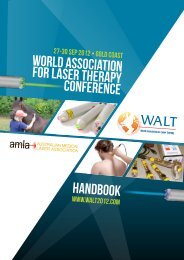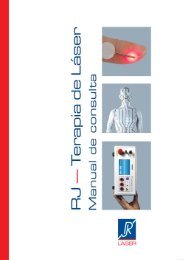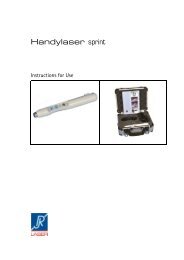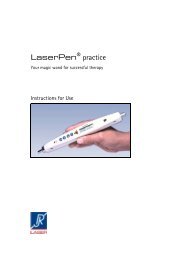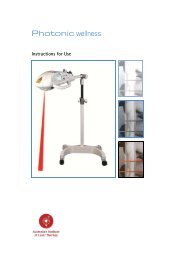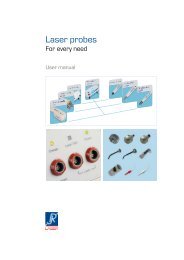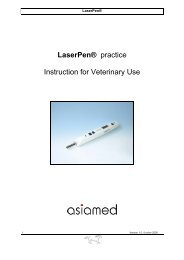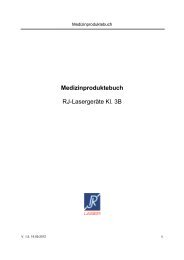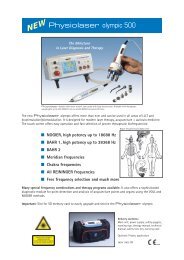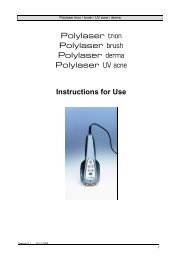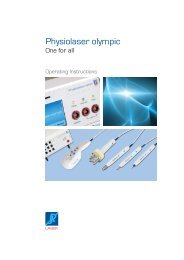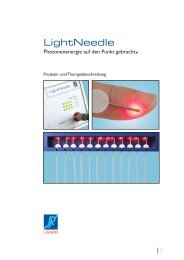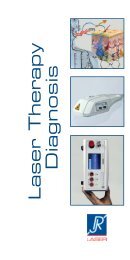LightNeedle - RJ Laser
LightNeedle - RJ Laser
LightNeedle - RJ Laser
You also want an ePaper? Increase the reach of your titles
YUMPU automatically turns print PDFs into web optimized ePapers that Google loves.
16<br />
100<br />
80<br />
~ 60<br />
m<br />
N<br />
I<br />
N<br />
I<br />
40<br />
20<br />
O<br />
35<br />
G. Litscher<br />
30 .<br />
25<br />
20<br />
10<br />
Figure 4.<br />
.<br />
.<br />
.<br />
.<br />
.<br />
SEFr<br />
Box plots of alterations of BIS and SEF values ( r: right; I: left) in<br />
25 healthy volunteers before (a), during (b-f) and after (g) acu-<br />
pressure (cf. Fig. 2) on the acupoint Yintang. The ends of the boxes<br />
define the 25%0 and 75%0, with a line at the median and error<br />
bars defining the 10%0 and 90%0.<br />
Before the subjects were stimulated, their mean<br />
BIS values (:tSD) were 97.4 (98-95) :t 1.0 andtheir<br />
mean SEF values (:tSD) were 23.9 :t 4.1 (right) and<br />
23.5 :t 4.9Hz (left). The BIS and SEF values both<br />
decreased significantly (P < 0.001) after starting acupressure.<br />
After 5 min acupressure at the acupoint<br />
Yintang, the mean BIS values were 62.9 (minimum<br />
35; see no.14 in Fig. 3) :t 13.9, and the mean SEF<br />
values were 13.3 (minimum 2.9) :t 8.1 (right) and<br />
13.8 (minimum 2.7) :!: 7.3 Hz (left). The release of<br />
acupressure caused an increase in BIS and SEF back<br />
to the baseline values before stimulation (cf Fig. 4).<br />
Figure 5 summarizes the BIS and SEF results<br />
obtained during manual needle acupuncture,<br />
<strong>Laser</strong>needle @ acupuncture and acupressure on the<br />
control point. Significant (P < 0.05) changes were<br />
found in BIS values during <strong>Laser</strong>needle@ acupuncture<br />
(measuring points d and e; cf Figs. 2 and 5) and<br />
during acupuncture on the control point (measuring<br />
points d-f). After 7.5 min <strong>Laser</strong>needle@ acupuncture at<br />
acupoint Yintang, the mean BIS values (:!:SD) were<br />
95.4 (minimum 81; see Fig. 5, middle, upper panel)<br />
:!: 4.1. After 5 min acupressure at the control point,<br />
the mean BIS values (:!:SD) were 94.2 (minimum 77;<br />
see Fig. 5, right, upper panel) :!: 4.8. SEF did not show<br />
any significant alteration.<br />
The results of the analysis of the VSS are demonstrated<br />
in Figure 6. The VSS values were significantly<br />
(P < 0.001) reduced after pressure application on<br />
Yintang, needle acupuncture and <strong>Laser</strong>needle@<br />
acupuncture but also after pressure application on<br />
the control point (P = 0.012). Mean baseline VSS<br />
values were insignificantly lower in <strong>Laser</strong>needle@<br />
and control conditions.<br />
HR and BP values (mean :!: SD) before and after<br />
acupressure at Yintang were calculated to be 73.2 :!:<br />
12.4beatsmin-l, 109.8:!: 14.0mmHg (systolic) and<br />
69.3 :!: 10.6 mmHg (diastolic), respectively. After<br />
stimulation the values decreased to 63.7 :!:<br />
11.9beatsmin-l, 107.7:!: 8.7mmHg(systolic)and<br />
66.8 :!: 8.6 mmHg (diastolic), respectively.<br />
Discussion<br />
The BIS and the SEF are mainly used intraoperatively<br />
to monitor the hypnotic effect of anaesthetic drugs.<br />
There are several studies reported in the literature<br />
proposing target values for EEG parameters to guide<br />
the depth of anaesthesia. A number of authors have<br />
reported a low probability of recall and a high probability<br />
of unresponsiveness during surgery at a level<br />
of 60 for BIS [8,9]. BIS values



